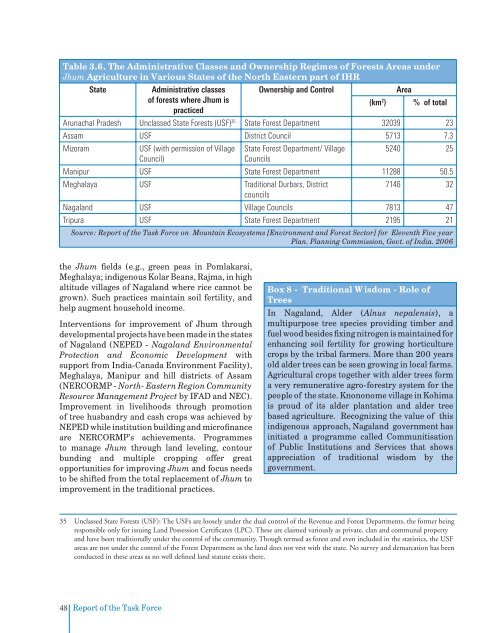Task Force Report - Govind Ballabh Pant Institute of Himalayan ...
Task Force Report - Govind Ballabh Pant Institute of Himalayan ...
Task Force Report - Govind Ballabh Pant Institute of Himalayan ...
Create successful ePaper yourself
Turn your PDF publications into a flip-book with our unique Google optimized e-Paper software.
Table 3.6. The Administrative Classes and Ownership Regimes <strong>of</strong> Forests Areas under<br />
Jhum Agriculture in Various States <strong>of</strong> the North Eastern part <strong>of</strong> IHR<br />
State<br />
Administrative classes Ownership and Control<br />
Area<br />
<strong>of</strong> forests where Jhum is<br />
practiced<br />
(km 2 ) % <strong>of</strong> total<br />
Arunachal Pradesh Unclassed State Forests (USF) 35 State Forest Department 32039 23<br />
Assam USF District Council 5713 7.3<br />
Mizoram<br />
USF (with permission <strong>of</strong> Village<br />
Council)<br />
State Forest Department/ Village<br />
Councils<br />
5240 25<br />
Manipur USF State Forest Department 11288 50.5<br />
Meghalaya USF Traditional Durbars, District<br />
7146 32<br />
councils<br />
Nagaland USF Village Councils 7813 47<br />
Tripura USF State Forest Department 2195 21<br />
Source: <strong>Report</strong> <strong>of</strong> the <strong>Task</strong> <strong>Force</strong> on Mountain Ecosystems [Environment and Forest Sector] for Eleventh Five year<br />
Plan. Planning Commission, Govt. <strong>of</strong> India. 2006<br />
the Jhum fields (e.g., green peas in Pomlakarai,<br />
Meghalaya; indigenous Kolar Beans, Rajma, in high<br />
altitude villages <strong>of</strong> Nagaland where rice cannot be<br />
grown). Such practices maintain soil fertility, and<br />
help augment household income.<br />
Interventions for improvement <strong>of</strong> Jhum through<br />
developmental projects have been made in the states<br />
<strong>of</strong> Nagaland (NEPED - Nagaland Environmental<br />
Protection and Economic Development with<br />
support from India-Canada Environment Facility),<br />
Meghalaya, Manipur and hill districts <strong>of</strong> Assam<br />
(NERCORMP - North- Eastern Region Community<br />
Resource Management Project by IFAD and NEC).<br />
Improvement in livelihoods through promotion<br />
<strong>of</strong> tree husbandry and cash crops was achieved by<br />
NEPED while institution building and micr<strong>of</strong>inance<br />
are NERCORMP’s achievements. Programmes<br />
to manage Jhum through land leveling, contour<br />
bunding and multiple cropping <strong>of</strong>fer great<br />
opportunities for improving Jhum and focus needs<br />
to be shifted from the total replacement <strong>of</strong> Jhum to<br />
improvement in the traditional practices.<br />
Box 8 - Traditional Wisdom - Role <strong>of</strong><br />
Trees<br />
In Nagaland, Alder (Alnus nepalensis), a<br />
multipurpose tree species providing timber and<br />
fuel wood besides fixing nitrogen is maintained for<br />
enhancing soil fertility for growing horticulture<br />
crops by the tribal farmers. More than 200 years<br />
old alder trees can be seen growing in local farms.<br />
Agricultural crops together with alder trees form<br />
a very remunerative agro-forestry system for the<br />
people <strong>of</strong> the state. Knononome village in Kohima<br />
is proud <strong>of</strong> its alder plantation and alder tree<br />
based agriculture. Recognizing the value <strong>of</strong> this<br />
indigenous approach, Nagaland government has<br />
initiated a programme called Communitisation<br />
<strong>of</strong> Public Institutions and Services that shows<br />
appreciation <strong>of</strong> traditional wisdom by the<br />
government.<br />
35 Unclassed State Forests (USF): The USFs are loosely under the dual control <strong>of</strong> the Revenue and Forest Departments, the former being<br />
responsible only for issuing Land Possession Certificates (LPC). These are claimed variously as private, clan and communal property<br />
and have been traditionally under the control <strong>of</strong> the community. Though termed as forest and even included in the statistics, the USF<br />
areas are not under the control <strong>of</strong> the Forest Department as the land does not vest with the state. No survey and demarcation has been<br />
conducted in these areas as no well defined land statute exists there.<br />
48<br />
<strong>Report</strong> <strong>of</strong> the <strong>Task</strong> <strong>Force</strong>

















